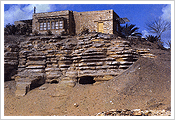| Memphis, Saqqara and the "escarpment of 'Ankhtawy"
Saqqara is the main part of the extensive necropolis of the ancient city of Memphis (in Egyptian Mennefer). In the center of the site, close to its eastern limit, there is a district called the Bubasteion, where the French Archaeological Mission of the Bubasteion (MAFB/FAMB), began to work some thirty years ago, under the direction of Alain Zivie. The Bubasteion precinct with its temples (and its numerous tombs) was dedicated to the goddess Bastet or Bubastis, hence the Greek name of Bubasteion. In Egyptian, this part of the site was also called “the West of Memphis” or the “escarpment/cliff of the ‘Ankh-awy” and Bastet was known as the Lady of ‘Ankktawy, this last name being also the designation of a quarter of Memphis itself.
At its origin, Memphis (Mennefer) was called The White Wall (in Egyptian Inebhedj). It became the town par excellence of the pharaonic divine kingship, the place of the crowning of the new kings and the site of their main palace, in other words the capital-city of the Old Kingdom. This is well known, but in the same time it is striking to see that virtually nothing remains of this period. However the cemeteries have survived, at least partly. And what cemeteries! Built at the edge of the western desert, these are, from North to South, Giza, Abusir, Saqqara, Dahshur, Meydum; all associated with the most famous monuments of Egypt: the pyramids. But Memphis did not loose its importance after the Old Kingdom, especially during the second half of the next millennium. Nevertheless, and in spite of all the evidence, it seems to be difficult for the non-specialists to acknowledge the importance of the city and of its cemeteries during a big part of the glorious period of the New Kingdom. Even some Egyptologists not involved in this field are still disposed to believe that Thebes has always been the true focus-point of this period, with of course two other important towns : Akhetaton (Amarna), the ephemeral creation of Amenhotep IV/Akhenaton, and Pi-Ramses, the Delta residence of the first Ramessides.
Of course, it can be difficult to imagine what a flourishing and active city Memphis was under the last pharaohs of the Eighteenth and the first ones of the Nineteenth dynasties, when we see the poor condition of the site today. Decades ago, the aspect of these ruins was rather romantic, recalling the paintings of early travellers; nowadays, it is just discouraging. But in spite of its actual miserable aspect, the ancient Memphis is not completely lost for archaeology. Survey and field-work ceased in the fifties for a long time, but they have been resumed since the beginning of the eighties. One of the main results is the discovery that the site of the town extended eastwards in the New Kingdom, as the bed of the Nile did. On the new fields left by the river, Ramses II built a huge temple whose some remains are still visible down the hill (the tell in Arabic) of Mît Rahina (particularly elements of the hypostyle hall and colossi). And it is striking that the few spectacular remains of the town itself of Memphis date back to the New Kingdom. Such is the case of the beautiful alabaster sphinx and of the famous colossus of Ramses II lying under its shelter.
The New Kingdom Memphis was not only a foremost religious center with its temple of the god Ptah and so many other sanctuaries, as the goddesses Sekhmet, half lioness half woman, and Hathor, the god child Nefertum, or the bull Apis, incarnation of Ptah and symbol of the ancient Egyptian kingship (which lived in a special place in the city and which, once dead, was buried in its own tomb at Saqqara, at first in individual burial vault, and later in a huge niche opening on a vast gallery). The city was also one of the most active centers, if not the first one, of the country, for the army, the treasure, the craftsmen, the sailors (with the important harbour of Perounefer). A big part of the middle-rank and high officials lived there and were buried in the neighbouring cemeteries, mainly at Saqqara. So, if we want to follow the track of these dignitaries and to get a better understanding of the New Kingdom Memphis, and eventually to obtain a good picture of the Egyptian New Kingdom, which will complete and correct the image we have elaborated from Thebes, we must explore all the tombs, even unattractive at the first glance, as the tombs located in the Bubasteion area. In the Late and Greek (Ptolemaic) Period, the Bubasteion site was used or reused as catacombs for the cats of the goddess Bastet, buried there for centuries. The New Kingdom tombs of the site, often cut in the rock (hypogea), had been partly reused for these animal burials, and had been lost and forgotten.
Therefore, concealed behind the presence of these huge numbers of cat mummies, the New Kingdom cemetery was, so to speak, scientifically virgin some twenty-five years ago. Yet it was an important area of the necropolis, for it corresponded, at least in part, to what the ancient Egyptians called the dehenet of ‘Ankhtawy, that is, the plateau, or rather the cliff, the escarpment of this suburban zone of Memphis. It was there that Egyptians aspired to be buried, according to the inscriptions. We understand. If it was necessary to depart this world and receive a burial, then let it be in this rather well-situated corner of the necropolis, not too isolated in the desert, like others, above the palm groves and gardens of Memphis, and placed more or less under the protection of ancient kings and their pyramids, and of great sages of yesteryear and their mastabas. In sum, a convenient anchorage, one not devoid of grandeur and beauty, to face eternity! The principal ambition of the Mission of the Bubasteion was and is to restore to this site the entire place it merits in the history and the archaeology of the New Kingdom. Our intent is to demonstrate that this was an extremely significant complex, where important personages of Dynasties 18 and 19 were buried, and that the appearance and the decoration of their tombs and their content have proved, and will prove, to be remarkable compared to contemporary monuments in the other major sites of the land. These tombs were the Memphite pendant to the New Kingdom “tombs of the nobles” at Thebes. The great city of Memphis was never dethroned by Thebes, indeed, far from it.
© A. Zivie (partly adapted from The Lost Tombs of Saqqara, Toulouse, 2007)
|
 |
|
| |
 |
A partial view of the southern side
of the Bubasteion escarpment
in the seventies
© Hypogées (A. Zivie/MAFB) |
|
